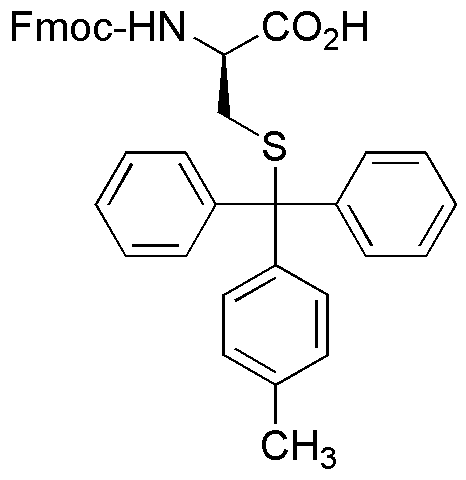Fmoc-S-4-methyltrityl-D-cysteine is widely utilized in research focused on:
- Peptide Synthesis: This compound serves as a protecting group in the synthesis of peptides, allowing for the selective modification of amino acids. Its stability under various conditions makes it ideal for complex peptide sequences.
- Drug Development: Researchers employ this chemical in the development of peptide-based pharmaceuticals, enhancing the efficacy and stability of drug candidates, particularly in targeting specific biological pathways.
- Bioconjugation: It is used in bioconjugation processes to attach biomolecules to surfaces or other molecules, facilitating the creation of targeted drug delivery systems and diagnostic tools.
- Research in Cancer Therapy: The compound is explored in the design of novel anticancer agents, leveraging its ability to modify peptide structures that can selectively target cancer cells.
- Protein Engineering: This chemical aids in the engineering of proteins with desired properties, contributing to advancements in biotechnology and synthetic biology applications.
General Information
Properties
Safety and Regulations
Applications
Fmoc-S-4-methyltrityl-D-cysteine is widely utilized in research focused on:
- Peptide Synthesis: This compound serves as a protecting group in the synthesis of peptides, allowing for the selective modification of amino acids. Its stability under various conditions makes it ideal for complex peptide sequences.
- Drug Development: Researchers employ this chemical in the development of peptide-based pharmaceuticals, enhancing the efficacy and stability of drug candidates, particularly in targeting specific biological pathways.
- Bioconjugation: It is used in bioconjugation processes to attach biomolecules to surfaces or other molecules, facilitating the creation of targeted drug delivery systems and diagnostic tools.
- Research in Cancer Therapy: The compound is explored in the design of novel anticancer agents, leveraging its ability to modify peptide structures that can selectively target cancer cells.
- Protein Engineering: This chemical aids in the engineering of proteins with desired properties, contributing to advancements in biotechnology and synthetic biology applications.
Documents
Safety Data Sheets (SDS)
The SDS provides comprehensive safety information on handling, storage, and disposal of the product.
Product Specification (PS)
The PS provides a comprehensive breakdown of the product’s properties, including chemical composition, physical state, purity, and storage requirements. It also details acceptable quality ranges and the product's intended applications.
Certificates of Analysis (COA)
Search for Certificates of Analysis (COA) by entering the products Lot Number. Lot and Batch Numbers can be found on a product’s label following the words ‘Lot’ or ‘Batch’.
Numéro de catalogue
Numéro de lot/série
Certificates Of Origin (COO)
This COO confirms the country where the product was manufactured, and also details the materials and components used in it and whether it is derived from natural, synthetic, or other specific sources. This certificate may be required for customs, trade, and regulatory compliance.
Numéro de catalogue
Numéro de lot/série
Safety Data Sheets (SDS)
The SDS provides comprehensive safety information on handling, storage, and disposal of the product.
DownloadProduct Specification (PS)
The PS provides a comprehensive breakdown of the product’s properties, including chemical composition, physical state, purity, and storage requirements. It also details acceptable quality ranges and the product's intended applications.
DownloadCertificates of Analysis (COA)
Search for Certificates of Analysis (COA) by entering the products Lot Number. Lot and Batch Numbers can be found on a product’s label following the words ‘Lot’ or ‘Batch’.
Numéro de catalogue
Numéro de lot/série
Certificates Of Origin (COO)
This COO confirms the country where the product was manufactured, and also details the materials and components used in it and whether it is derived from natural, synthetic, or other specific sources. This certificate may be required for customs, trade, and regulatory compliance.


